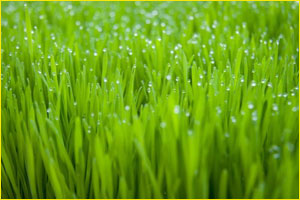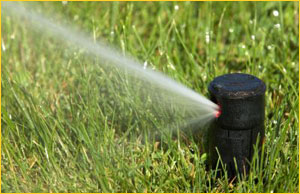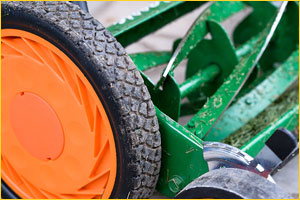Lawn Tips
Lawn Care is more than just mowing the lawn!
 Clean the lawn. Clean the lawn.
Before beginning regular lawn maintenance in the spring, rake up accumulated leaves. Remove fallen leaves as soon as possible in the fall. Look for other forms of debris, and remove from the area. Accumulated debris on the lawn whether it's from tree leaves or other items, block the sunlight and will cause the grass to fail.
Because grass grows best when it is regularly cut (grass is one of the few plants in the world that actually thrive from being cut) mowing the lawn should be looked at carefully. Ideally, lawns should be somewhat level for ideal mowing. That doesn't mean you have to live on a completely flat property, it does mean that your lawn should be as even as possible to avoid having the mower jump up and down as you push it. This up and down motion often results in scalping the lawn which causes many problems for the health of the grass. If your yard has high or low spots in the lawn try doing the following:
Fill holes with topsoil and over-seed with a similar grass as what is already growing in your lawn.
Remove bumps by cutting an X in the raised area with a shovel. Carefully peel back the sod and remove as much soil as necessary. Place the sod back in place and water.
Inspect for damage regularly
Inspect for disease, insects and weeds on a regular basis. Mowing is a great time to keep an eye out for these problems. Learn to recognize and treat problems quickly and appropriately before they become big problems.
Soil tests are the best
Do a soil test. Follow the recommendations that accompany soil test results. When applying fertilizer, follow directions carefully. Only add necessary amendments recommended by the test results. This will tell you if your soil needs additional elements to successfully grow grass. The test might show that it's pH levels are out of whack and you might need to add lime periodically. The soil test will tell you if there's enough phosphorus in the soil, and if there's plenty, then you can use a phosphorus-free fertilizer. The soil test will also tell you how healthy the soil is, that is, if your soil has lots of microbe activity or is it a sterile piece of dirt. If there's a lot of microbe activity, that's good, if it's sterile, then you'll want to add additional organic material.
Compacted soils
Check for soil compaction. Compacted soils do not create an environment good for root development and for microbe activity. Aerating compacted soils regularly helps to loosen up the soil and provide additional opportunities for root development and increased microbe development. Aeration also helps to keep thatch layers in check. Early spring and summer are the best times to aerate your lawn. Compacted soils prevent water and air from reaching the roots and also causes runoff. Areas that repeatedly have standing water after heavy rains are likely to be compacted.
Excess thatch build up could be a problem
Check for excess thatch and remove. A thatch layer that's too thick (over 1/2") promotes a shallow root system that can't survive dry weather. This is best done in the fall and before fertilizing. Remove the debris caused by dethatching.
Good maintenance of your lawn helps keep your lawn healthy and in better shape visually.
Grass clippings do not contribute significantly to thatch accumulation on lawns.
Watering
 A major detriment to lawn attractiveness during the summer is a lack of soil water. During the hot, dry periods, growth of most of our lawn grasses will cease and the grass will turn brown and go dormant if supplemental water is not provided. The dormant grass is in a resting stage and will normally revive with favorable moisture and temperature conditions in the fall. Lawn attractiveness is, however, lost during dormancy, and weed growth, which detracts from the appearance of the lawn, may be greater. Dormant lawns will not normally need to be mowed. A major detriment to lawn attractiveness during the summer is a lack of soil water. During the hot, dry periods, growth of most of our lawn grasses will cease and the grass will turn brown and go dormant if supplemental water is not provided. The dormant grass is in a resting stage and will normally revive with favorable moisture and temperature conditions in the fall. Lawn attractiveness is, however, lost during dormancy, and weed growth, which detracts from the appearance of the lawn, may be greater. Dormant lawns will not normally need to be mowed.
During the driest period of the summer, our lawns usually will require about one inch of water every week to stay green and growing. Lawn sprinklers usually need to be set for at least one to two hours per spot to apply one inch of water. One inch of water will typically wet a soil to a depth of six to eight inches. Overwatering and/or frequent watering will stimulate excessive topgrowth and the need for more frequent mowing. Lawns watered too frequently also tend to develop shallow roots, which may make them more susceptible to pests and heat-drought stress. Water infrequently (weekly) and deeply (six to eight inches) with one inch of water each time.
The best time to water is early morning, so less water is lost by evaporation. The worst time to water is in the evening because the lawn stays wet all night, which encourages disease development.
Mowing
 Mow grass to the proper height with a mower with a sharp blade. Never cut off more than 1/3 of the blade when mowing. Grass needs the surface area of the blade to sustain itself. Removing too much of the blade creates an environment ripe for disease. Mow grass to the proper height with a mower with a sharp blade. Never cut off more than 1/3 of the blade when mowing. Grass needs the surface area of the blade to sustain itself. Removing too much of the blade creates an environment ripe for disease.
Don't blow grass clippings into the street. They end up in the storm sewer and only add additional nutrients to already nutrient laden streams and rivers.
Improve light penetration
Prune trees and shrubs to let sun and air circulate. This helps promotes growth and discourages disease.
Maintain equipment with periodic checkups
Take care of lawn equipment, both before and after the growing season. This insures that your lawn mower will work as it's supposed to, but will do an excellent job of cutting the grass in a way that doesn't damage the turfgrass in the process.
|

